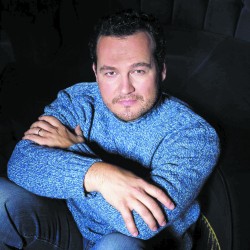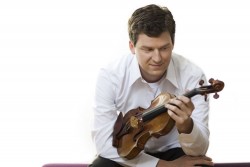It’s impossible, given the copious concert-going options available each month, to note adequately all those that fall within the scope of this column. Each month, I take a deep breath and then choose a cluster of concerts, a theme, a genre, a group of artists or composers, to fill the few precious pages allotted to the Classical & Beyond beat, knowing full well that I will have left out innumerable events equally deserving of coverage. Such is the nature of the beast.
I’m aware, as well, that many concerts warrant more than the scant lines I’m able to afford them. Sometimes though, when the date of a short-shrifted concert falls within the first seven days of the month, thus overlapping two issues, I get to redeem myself. And while it means less space still for the newer listings, well ... I’ve resigned myself to the fact that there will always be those irked and annoyed at me for the concerts I select to write about each month: such, too, is the nature of the beast.
Redemption via Rachmaninoff: Hence my decision to revisit the Etobicoke Philharmonic Orchestra’s upcoming April 5 performance of Rachmaninoff’s Piano Concerto No. 3, with the distinguished pianist, Arthur Ozolins. In its 52-year history, the EPO has never performed the Rachmaninoff Third. For its 50th anniversary gala, however, Ozolins played Rachmaninoff’s Second with the orchestra. Sabatino Vacca, the EPO’s music director, tells what happened afterward:
“As we were coming offstage I gently remarked that we really should do the Third sometime. He politely declined, knowing how demanding a piece it is and how demanding he would be of himself to prepare it. I knew it was a lot to ask so I was not too disappointed. A few months passed and Arthur then called us to see if in fact it were possible to program the Third as he was considering playing it after all. You cannot imagine how delighted I was! I immediately began to see where it would best fit into our current season.”
Vacca goes on to describe the thrill of rehearsing the concerto in the two-piano version with Ozolins; of getting a glimpse into ‘’just how thoroughly Mr. Ozolins prepares a concerto; no ‘note’ is left unturned!” And how Ozolins “often manages, somehow to play both [piano parts] at the same time!” Though Ozolins has played it throughout his long career, Vacca remarks on the “boyish curiosity” that comes through Ozolin’s preparation, “as if coming to it for the first time, always discovering new things.”
Interestingly, in an audio interview with Paul Robinson (posted July 31, 2010 — date of conversation unknown; theartoftheconductor.podbean.com), Ozolins speaks endearingly of his early childhood exposure to (and enduring affinity for) the music of Rachmaninoff:
“I used to sit under my mother’s piano when she was practising before she died. [Ozolins was only five and a half.] Then afterward my grandmother kept playing because she was also a graduate from the St. Petersburg Conservatory in Russia. And she knew Rachmaninoff; and she just almost constantly was practising the First and the Second piano concertos of Rachmaninoff. Maybe that’s why I have such an identification with Rachmaninoff. I just adore Rachmaninoff so much; I’ve heard it ever since a child.”
Vacca clearly appreciates Ozolins’ deep connection to Rachmaninoff’s music, acknowledging that “it will be a great experience and privilege for us to perform [the Third Concerto] with someone who counts it as one of his signature pieces. “It will be,” he enthuses, “a rare opportunity for the Etobicoke community and beyond to hear Mr. Ozolins perform this concerto, one of the pinnacles of ultra-Romantic bravura pianism.”
It seems rather fitting that this exceptional concert, which gets under way at 8pm, is being performed at Martingrove Collegiate, home to the gifted program in Etobicoke. There certainly will be no shortage of musical gifts emanating from the stage that night.
 115 years young: The EPO may be in its 52nd year, but it’s a mere tot compared to the Women’s Musical Club of Toronto, now in its 115th season — yes, 115, and going strong — it announced season 116 last month! And of course, the wonderful women — and men — of the WMCT are celebrating the organization’s 115th anniversary in grand style. On May 2 at 1:30pm, the stage of Koerner Hall will be graced by Canadian musical luminaries, violinist James Ehnes and baritone Russell Braun. Collaborative pianist Carolyn Maule, who happens to be married to Braun, joins them.
115 years young: The EPO may be in its 52nd year, but it’s a mere tot compared to the Women’s Musical Club of Toronto, now in its 115th season — yes, 115, and going strong — it announced season 116 last month! And of course, the wonderful women — and men — of the WMCT are celebrating the organization’s 115th anniversary in grand style. On May 2 at 1:30pm, the stage of Koerner Hall will be graced by Canadian musical luminaries, violinist James Ehnes and baritone Russell Braun. Collaborative pianist Carolyn Maule, who happens to be married to Braun, joins them.
How do you get two of the busiest classical musicians on the planet to perform together? How does the program get chosen? How long does it take to nail down the details? And the venue? Last week I put these questions to WMCT’s artistic director, Simon Fryer (concurrently principal cello with the Regina Symphony, head of strings at the Regina Conservatory and active chamber musician), and here’s what he told me:
“The idea for this project came forward in the course of a discussion with Russell in Parry Sound at the 2009 Festival of the Sound. Both artists have been long-time favorites of the WMCT so when Russell mentioned that they had been talking about collaborating it was a no-brainer to grab the idea and run with it. The details of programming took longer to pin down but Russell had clear and wonderful ideas to build around and once the skeleton was in place James was able to fit appropriate works into it. These are both major artists with very busy schedules, but once we had a good handle on the program direction it fell into place nicely. With such possibilities the project was an obvious choice to present at a major event in Koerner Hall.”
Simple, eh? But it took a lot more than just being at the right place at the right time. Fryer’s background, experience and personality all contributed to his being at that “right place.” In asking what drew him to the WMCT position, which he assumed in 2005/6 — planning was then under way for the 110th season — he shed some light on all three:
“I had left the Toronto Symphony to join the Penderecki String Quartet in 2003. My sheepdog personality enjoys collecting artists and audiences together with great music, so bringing ideas for musical events and collaborations to reality had always been an interest for me. With many such events behind me, the opportunity to consolidate from random events to a coherent season was something I began to search for.
“The opportunity presented itself in the form of the WMCT. Here was an organization in strong financial shape, with a loyal and knowledgeable audience, looking for artistic direction from the professional arena for the first time ... I had known of the WMCT ever since I arrived in Toronto and was impressed by the people I met with and their clear sense of purpose.”
 To what does he attribute the WMCT’s unparalleled success and how does he plan to sustain it?
To what does he attribute the WMCT’s unparalleled success and how does he plan to sustain it?
“The success of the series over 115 years is a result of careful management, strong understanding of the tastes of the members and a large and enthusiastic resource of volunteers. It is my job to maintain and build that understanding so that tastes are developed and new horizons approached. Continuing the tradition of bringing a spectrum of Canadian and international artists to the WMCT stage, is a fascinating and rewarding task. I do not work alone either — I have a wonderful artists selection committee that provides both an expert sounding board for ideas and a superb resource of knowledge.”
It sounds like the WMCT is in very savvy and capable hands under Fryer’s artistic leadership.
And now back to the big event. While it won’t be the first time Ehnes and Braun will be sharing the stage for a WMCT concert — that happened in 1998 at the WMCT’s centennial celebration concert– it will be their first time actually playing together. (A further “fun fact”: in 1992 both Ehnes and Braun made their Toronto debuts with the WMCT in season 95, within a month of each other.)
The afternoon will begin with works by Bach (the first for voice and violin; the second for solo violin) and will end with settings of English songs based on poet A. E. Housman’s A Shropshire Lad, by Vaughan Williams, Butterworth and Barber, for the combinations of voice and violin, voice and piano, and voice, violin and piano. In between you’ll get to marvel at Ehnes’ virtuosity with three Paganini caprices, and luxuriate in Braun’s rich tones in Beethoven’s only song cycle. A new work for voice, violin and piano by John Estacio, commissioned by the WMCT for the occasion, will complete the outstanding program — one fit for this most exciting and monumental occasion!
In addition to these two magnificent evenings of music making, there are probably another 115 listings to consider for April and early May. It’s spring — time to step out and take in the season’s multitude of musical offerings. Enjoy!
Sharna Searle trained as a musician and lawyer, practised a lot more piano than law and is listings editor at The WholeNote. She can be contacted at classicalbeyond@thewholenote.com.



